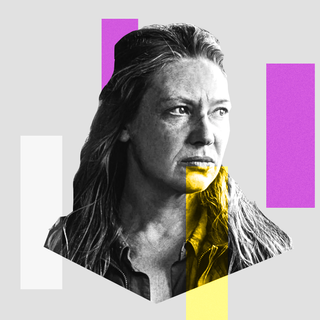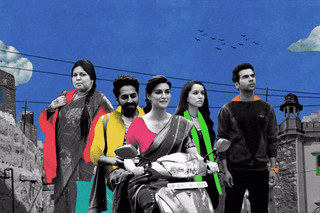
Why Bollywood Moved Away From Urban Romances in Favor of Small‑Town Ones
Socio-economic shifts in the country have changed what Indian audiences relish — and it is no longer the idealized NRI archetype.

Over the past decade, Bollywood has switched gears from urban romances like Jaane Tu… Ya Jaane Na (2008), Wake Up Sid (2009), and Break Ke Baad (2010) to romantic comedies set in small towns like Dum Laga Ke Haisha (2015), Bareilly Ki Barfi (2017), and Stree (2018). The marked shift is reflective of certain changes in India’s cultural landscape — shaped by a myriad of socio-economic factors — that Bollywood is attempting to keep up with.
“A majority of the viewers don’t live in Mumbai and New Delhi, and neither do they go to clubs,” Sucharita Tyagi, a renowned film critic, had told The Hindu. Small towns as backdrops, then, become relatable to audiences living — or, at the very least, hailing — from the hinterlands. While viewers from smaller towns may be able to relate to these stories, those from metros may find their lack of pretense to be a much-needed respite from their fast-paced lives.
Further, our cultural shift — to watching honest representations of human lives on screen — has also translated into the de-urbanization of Bollywood. “We associate a certain kind of stuffiness with the big-city rich, elite people, which goes away when you’re watching or reading stories about people that don’t have this stuffiness about them, and instead, have other things they are concerned about in their lives. This lack of pretense is a big thing on the internet right now, where you have to put your most honest foot forward if you want to resonate with people…” says Tyagi. “That’s why we’ve seen the rise of influencers from different kinds of cities. This also ties in together to the kinds of stories that we are interested in.”
In a sense, then, the narrative shift is one from fantasy to reality, too, according to Itisha Nagar, an assistant professor of psychology at Delhi University. This shift has actually been in the works for decades. The late 1990s and early 2000s saw the rise of movies featuring NRIs — like Dilwale Dulhania Le Jayenge (1995), Kabhi Khushi Kabhie Gham (2001), Kal Ho Naa Ho (2003), and Salaam Namaste (2005). From the mid-2000s to the early 2010s, foreign locales made way for metropolitan cities in India.
And now, as part of yet another gradual transition, small towns have replaced cities as the most frequent backdrop.
Related on The Swaddle:
For middle-class Indians, the “suave, educated, English-speaking” NRI ceases to be interesting beyond a point because they aren’t relatable, Nagar explains. Regional accents and dialects, on the other hand, are saleable fantasies that allow people to see themselves in the girl next door and relate to the conflicts of characters from small towns.
“At long last, Bollywood is turning its gaze away from gilded mirages and towards real stories of real India… Thanks to the internet, we truly do seem to have the entire world at our fingertips. This is why our films need to turn their enamored gazes away from foreign locales to unmapped domestic terrain instead,” writes Avinash Das, who hails from Bihar and has written and directed Anaarkali of Aarah (2017) set in the small town of Arrah, writes. “We can now claim that contemporary films represent the truth of our cities and our lived experiences.”
Bollywood’s affinity for romantic comedies, too, has played a part in steering filmmakers toward de-urbanizing stories. In small-town romances, love itself becomes an adventure, a daring act of defiance, setting the stage for ridiculous overtures and comical faux pas. While the narrow lanes of the locales present barely explored visuals, the infamous narrow-mindedness of its people often makes for hilarious escapades from local shopkeepers and nosey uncle-aunties known for their enthusiastic contributions to the town’s grapevine.
“Where is the conflict in love in a big city like Mumbai? Love is still difficult for those living in small cities,” says Tigmanshu Dhulia, who wrote and directed Milan Talkies (2019), a romance set in the small town of Allahabad, where Dhulia himself was born and raised.
It’s also the influx of filmmakers like Dhulia from smaller towns that have engineered part of the shift. With the increase in platforms for storytelling with the advent of OTT platforms, more screenwriters are now able to find producers for their stories and prove that the narratives are bankable. Tyagi notes that it’s relativelyeasier now to get one’s script approved than it was a few decades ago “when only a certain kind of person, who had certain kinds of contacts and connects, could become a screenwriter.”
Related on The Swaddle:
Inclusive Christmas Rom‑Coms Are Proof We Can Indulge in Nostalgia Without Being Bigoted
As journalist Lata Jha wrote in LiveMint, “[T]he trinity of Mumbai-bred film family scions Aditya Chopra, Sooraj Barjatya and Karan Johar has gradually had to compete with the likes of Kabir Khan, born in Hyderabad and educated in Delhi, Imtiaz Ali from Jamshedpur, and Anurag Kashyap and Abhinav Kashyap, who grew up in Uttar Pradesh. These filmmakers have, in turn, brought their own texture and narrative to filmmaking.”
The diversity of India, thus, is truly reflected in the stories of small towns from across the country rather than in the largely homogenous culture prevalent in the metros, which audiences have eventually tired of. Greater diversity also means more uncharted territory for filmmakers to explore and audiences to experience.
“For the last two decades or so, places we consider small towns have changed way beyond most people in the metros realize. As a result… smaller towns are now melting pots of views, counter-views, aspirations, oppositions, revolts, and compromises, which make them fascinating places for storytellers,” noted Jaideep Sahni, who has written films like Aaja Nachle (2007) and Shuddh Desi Romance (2013), both of which explore people’s outlook towards love in small towns.
These changes in India’s small towns that Sahni speaks of, are a result of India’s economic facelift over the last decade or so. “The growing economic stability of the country, the evolution of towns into cities, the spurt in multiplexes, the spread of digital platforms, and the self-confidence gained, as a result, might be responsible for how open and ready Indians are for a lot more stories about themselves,” Jha notes. “[T]he ability for these new, unique stories to be told and watched also comes from where India is as a society.”
For Hindi-speaking audiences, then, the stories present an opportunity to tread languages, cultures, and conflicts from parts of their own country that they may not have been privy to otherwise — in a way, it’s an excuse to truly understand the country’s diversity, through the personal stories of its people.
Devrupa Rakshit is an Associate Editor at The Swaddle. She is a lawyer by education, a poet by accident, a painter by shaukh, and autistic by birth. You can find her on Instagram @devruparakshit.
Related


Words Mean Things: ‘Appropriation’
